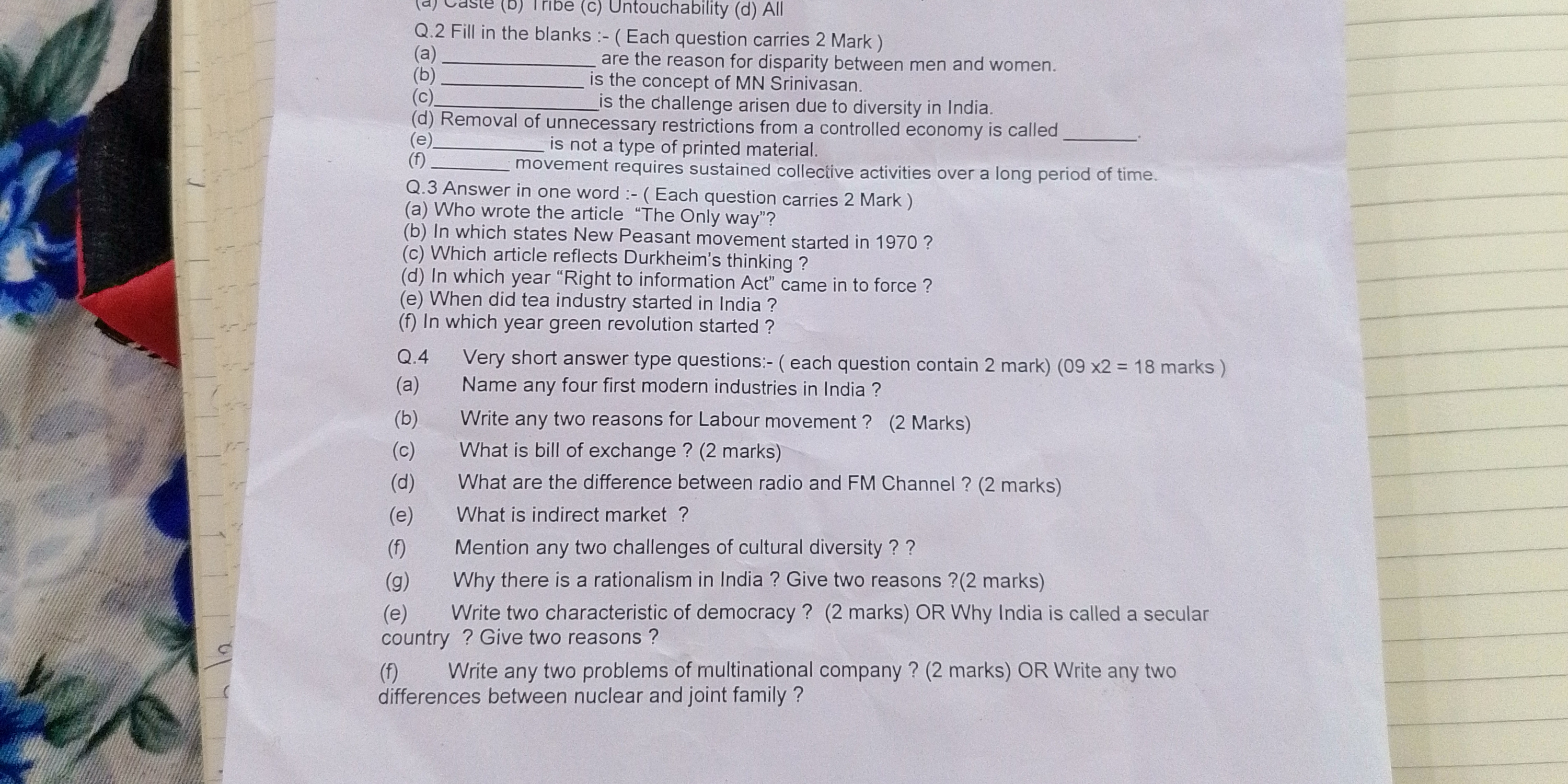Q.1 Fill in the blanks - (Each question carries 2 Marks) (a) __________ is the concept of MN Srinivasan. (b) __________ is the challenge arisen due to diversity in India. (c) _____... Q.1 Fill in the blanks - (Each question carries 2 Marks) (a) __________ is the concept of MN Srinivasan. (b) __________ is the challenge arisen due to diversity in India. (c) __________ is not a type of printed material. Q.2 Answer in one word - (Each question carries 2 Marks) (a) Who wrote the article 'The Only way'? (b) In which states New Peasant movement started in 1970? (c) Which article reflects Durkheim's thinking? (d) In which year 'Right to information Act' came in to force? (e) When did tea industry start in India? (f) In which year green revolution started? Q.4 Very short answer type questions: - (each question contain 2 marks) (09 x 2 = 18 marks) (a) Name any four first modern industries in India? (b) Write any two reasons for Labour movement? (c) What is bill of exchange? (d) What are the difference between radio and FM Channel? (e) What is indirect market? (f) Mention any two challenges of cultural diversity? (g) Why there is a rationalism in India? Give two reasons? (h) Write two characteristic of democracy? OR Why India is called a secular country? Give two reasons? (i) Write any two problems of multinational company? OR Write any two differences between nuclear and joint family?

Understand the Problem
The question appears to be a set of exam questions related to history and social studies, covering topics such as industrialization, movements, and aspects of democracy in India. It includes fill-in-the-blank questions, short answer prompts, and topics for discussion, indicating that it is intended for students to demonstrate their knowledge and understanding of these subjects.
Answer
(a) Sanskritization, (b) Cultural diversity, (c) Email, Lohia, Bihar, Article 25, 2005, 1835, 1960, Textiles, Steel, Shipbuilding, Sugar, Economic, Social, Legal, Older Generation, Different Views.
The final answer is: (a) Sanskritization, (b) Cultural diversity, (c) Email, (d) Lohia, Bihar, Article 25, 2005, 1835, 1960, Textiles, Steel, Shipbuilding, Sugar, Economic, Social, Legal, Older Generation, Different Views, Written order for payment, Broadcast area, Advertising revenue, Retailers, Cultural integration, Discrimination, Western influences, Education, Voting rights, Secular constitution, Tax evasion, Environmental impact, Independence, Peace, Socialization.
Answer for screen readers
The final answer is: (a) Sanskritization, (b) Cultural diversity, (c) Email, (d) Lohia, Bihar, Article 25, 2005, 1835, 1960, Textiles, Steel, Shipbuilding, Sugar, Economic, Social, Legal, Older Generation, Different Views, Written order for payment, Broadcast area, Advertising revenue, Retailers, Cultural integration, Discrimination, Western influences, Education, Voting rights, Secular constitution, Tax evasion, Environmental impact, Independence, Peace, Socialization.
More Information
M.N. Srinivasan is known for the concept of 'Sanskritization.' The concept relates to the social mobility of groups trying to improve their status by adopting the cultural norms of higher castes. Cultural diversity presents challenges like integration and discrimination.
Tips
Confusing communication mediums like email and traditional print is common; remember email is digital.
AI-generated content may contain errors. Please verify critical information